第一课物流英语简介
- 格式:ppt
- 大小:2.82 MB
- 文档页数:32
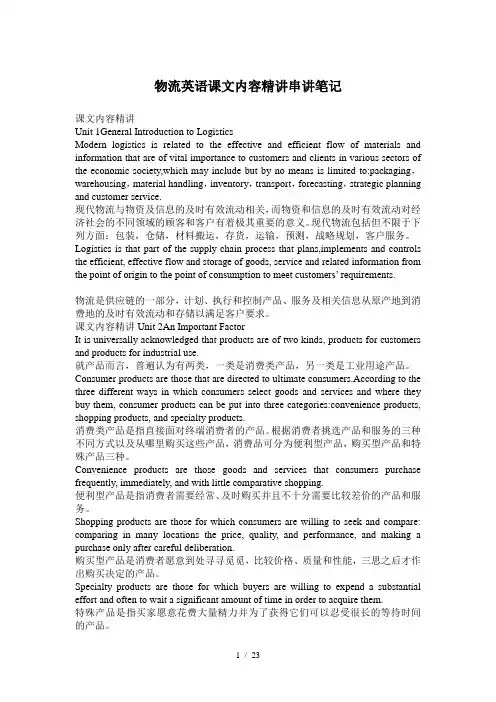
物流英语课文内容精讲串讲笔记课文内容精讲Unit 1General Introduction to LogisticsModern logistics is related to the effective and efficient flow of materials and information that are of vital importance to customers and clients in various sectors of the economic society,which may include but by no means is limited to:packaging,warehousing,material handling,inventory,transport,forecasting,strategic planning and customer service.现代物流与物资及信息的及时有效流动相关,而物资和信息的及时有效流动对经济社会的不同领域的顾客和客户有着极其重要的意义。
现代物流包括但不限于下列方面:包装,仓储,材料搬运,存货,运输,预测,战略规划,客户服务。
Logistics is that part of the supply chain process that plans,implements and controls the efficient, effective flow and storage of goods, service and related information from the point of origin to the point of consumption to meet customers’ requir ements.物流是供应链的一部分,计划、执行和控制产品、服务及相关信息从原产地到消费地的及时有效流动和存储以满足客户要求。
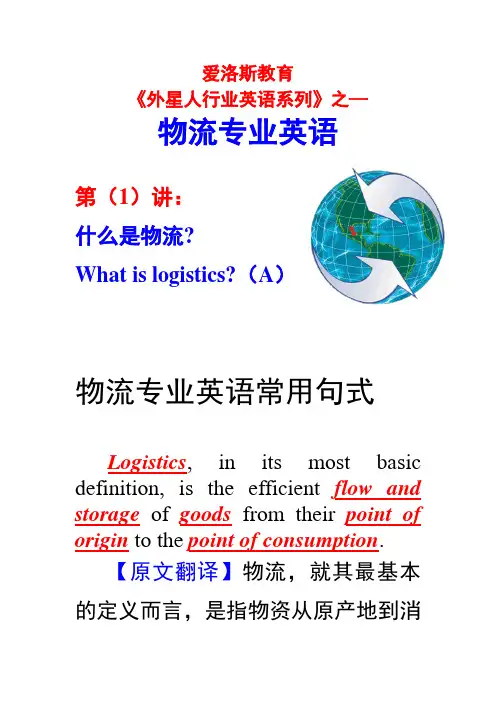
爱洛斯教育《外星人行业英语系列》之—物流专业英语第(1)讲:什么是物流?What is logistics? (A)物流专业英语常用句式Logistics, in its most basic definition, is the efficient flow and storage of goods from their point of origin to the point of consumption.【原文翻译】物流,就其最基本的定义而言,是指物资从原产地到消费地的高效流通和存储。
【物流术语提示】1.l ogistics n. 物流2.f low and storage3.(商品的)流动与储存4.g oods n. 商品,货物,物资5.p oint of origin原产地,产地= place of origin6.p oint of consumption消费地It is the part of the supply chain process that plans, implements and controls the efficient and effective flow of goods, services and related information.【原文翻译】它是供应链程序的一部分,对物资、服务和相关信息的高效及有效的流通进行规划、实施和控制。
【物流术语提示】7.s upply chain供应链8.p lan, implement and control规划,实施和控制9.flow of goods货物流,商品流10.flow of services服务流11.flow of information信息流****The End****Thank You。
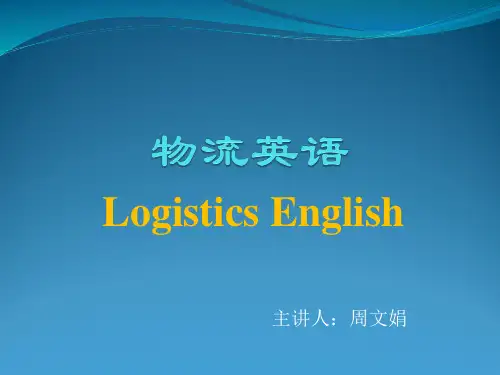
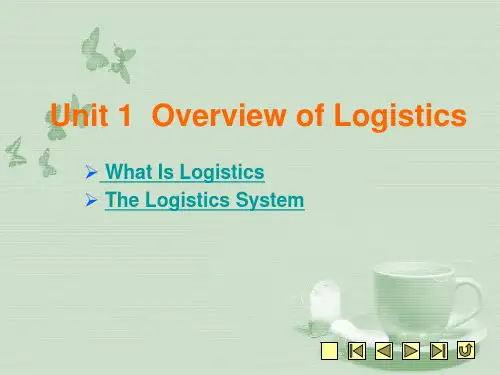
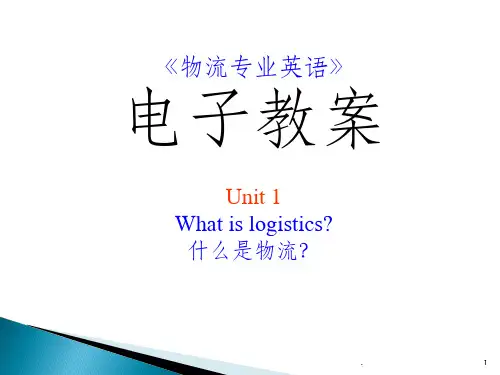
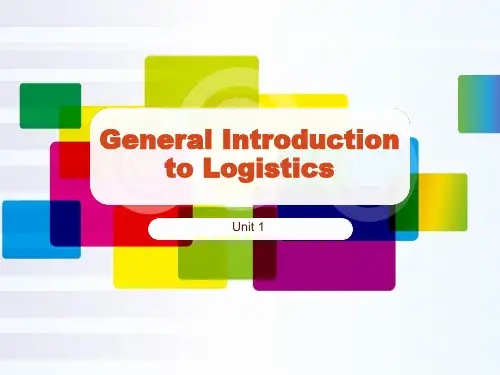
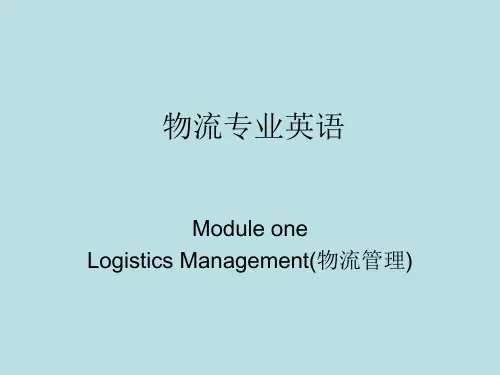
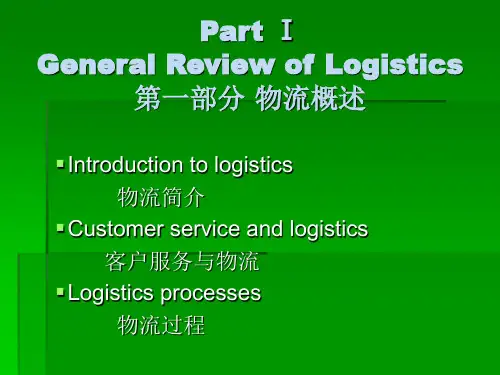
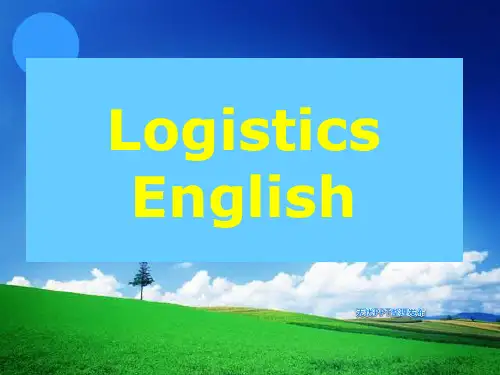

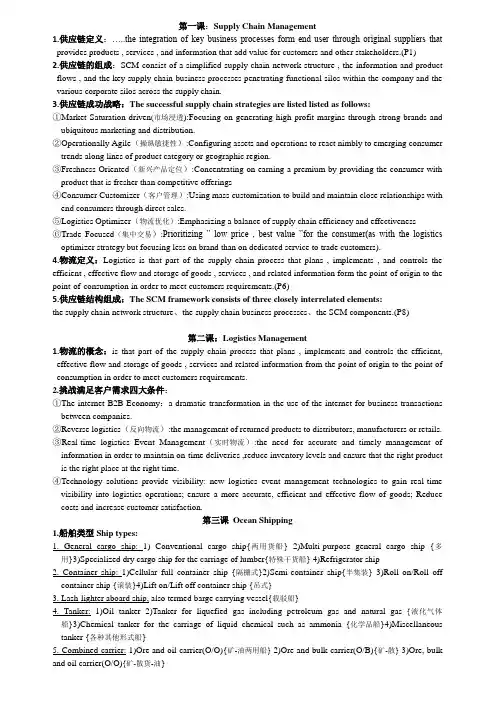
第一课:Supply Chain Management1.供应链定义:…..the integration of key business processes form end user through original suppliers that provides products , services , and information that add value for customers and other stakeholders.(P1)2.供应链的组成:SCM consist of a simplified supply chain network structure , the information and product flows , and the key supply chain business processes penetrating functional silos within the company and the various corporate silos across the supply chain.3.供应链成功战略:The successful supply chain strategies are listed listed as follows:①Market Saturation driven(市场浸透):Focusing on generating high profit margins through strong brands and ubiquitous marketing and distribution.②Operationally Agile(操纵敏捷性):Configuring assets and operations to react nimbly to emerging consumer trends along lines of product category or geographic region.③Freshness Oriented(新兴产品定位):Concentrating on earning a premium by providing the consumer with product that is fresher than competitive offerings④Consumer Customizer(客户管理):Using mass customization to build and maintain close relationships with end consumers through direct sales.⑤Logistics Optimizer(物流优化):Emphasizing a balance of supply chain efficiency and effectiveness⑥Trade Focused(集中交易):Prioritizing ” low price , best value ”for the consumer(as with the logistics optimizer strategy but focusing less on brand than on dedicated service to trade customers).4.物流定义:Logistics is that part of the supply chain process that plans , implements , and controls the efficient , effective flow and storage of goods , services , and related information form the point-of origin to the point-of-consumption in order to meet customers requirements.(P6)5.供应链结构组成:The SCM framework consists of three closely interrelated elements:the supply chain network structure、the supply chain business processes、the SCM components.(P8)第二课:Logistics Management1.物流的概念:is that part of the supply chain process that plans , implements and controls the efficient, effective flow and storage of goods , services and related information from the point of origin to the point of consumption in order to meet customers requirements.2.挑战满足客户需求四大条件:①The internet B2B Economy:a dramatic transformation in the use of the internet for business transactions between companies.②Reverse logistics(反向物流):the management of returned products to distributors, manufacturers or retails.③Real-time logistics Event Management(实时物流):the need for accurate and timely management of information in order to maintain on-time deliveries ,reduce inventory levels and ensure that the right product is the right place at the right time.④Technology solutions provide visibility: new logistics event management technologies to gain real-time visibility into logistics operations; ensure a more accurate, efficient and effective flow of goods; Reduce costs and increase customer satisfaction.第三课Ocean Shipping1.船舶类型Ship types:1. General cargo ship: 1) Conventional cargo ship{两用货船} 2)Multi-purpose general cargo ship {多用}3)Specialized dry cargo ship for the carriage of lumber{特殊干货船} 4)Refrigerator ship2. Container ship: 1)Cellular full container ship {隔栅式}2)Semi-container ship{半集装} 3)Roll on/Roll off container ship {滚装}4)Lift on/Lift off container ship {吊式}3. Lash-lighter aboard ship, also termed barge carrying vessel{载驳船}4. Tanker: 1)Oil tanker 2)Tanker for liquefied gas including petroleum gas and natural gas {液化气体船}3)Chemical tanker for the carriage of liquid chemical such as ammonia {化学品船}4)Miscellaneous tanker {各种其他形式船}5. Combined carrier: 1)Ore and oil carrier(O/O){矿-油两用船} 2)Ore and bulk carrier(O/B){矿-散} 3)Ore, bulk and oil carrier(O/O){矿-散货-油}2.海上运输类型:Type of ocean shipping service:1). Liners:①定义:Liners offer shipping space , as common carriers , on ships playing along fixed routes on regular schedule ,principally engaged in carrying general cargo in relatively small shipments and limited volumes .②特点:1)more calls along the route and a saving in time at port for loading and discharging, thus ensuring dispatch and delivery of shipments in good time2) feasibility of sending small installments of cargo instead of bulky shipments3) better technical equipment on board ship to ensure faster and safer sailing.2). Trampers :①定义:Trampers refers to ships playing on waterways without pre-set schedule or fixed routes and sailings normally depend on an availability of cargoes entrusted for carriages.②分类:time charter / voyage charter / demise charter* The Demise charter pay for: 1) Crew’s wages and provisions 2).Ship’s maintenance and stores3)Lubricating oil 4)Fresh water3.船舶证书Ship’s papers:I.主要重要证书包括:1.Certificate of Nationality 2.Certificate of seaworthiness 3.Certificate of Classification 4.Tonnage Certificate 5.Loadline Certificate 6.Rifrigerating Machinery Certificate 7.Wireless CertificateII.Certificate of Nationality: it is usual for the shipbuilder to issue a builder’s certificate giving detailed specifications of the shipIII.Certificate of Seaworthiness: it is imperative that a ship always maintains the technical standards and requirements for safe sailing at sea.IV.Certificate of Classification(船舶入籍证书): is an indication of the standard of a ship insofar as her structure , technical requirements and equipment are concerned , and since all necessary particulars are to be submitted to the organization concerned when classification of a ship is applied for ,an authentic record will be available of the state of the ship in question.V.Official Log Book(船员日志): An official log must be kept by every sea-going ship and the following matter must be record:1) A statement of conduct, character and the like of every member of the crew2) Every offence committed by a member of the crew, for which prosecution is intended3) Every conviction of a member of the crew and the punishment inflicted4) Every case of illness or injury or death happening to a member of the crew5) Every collision with any other ship and the circumstances leading themVI.Ship’s Articles (船员记录本) :give a description of crew and capacity in which each member serves, length of voyage ,amount of wages, ti me of commencement of voyage and scale of provisions.VII.Ship’s Log(航海日志):gives a daily record of the activities aboard a ship , either in port or in sailing . including loading and discharge of cargoes , weather conditions, position of ship when on voyage , time of departure and arrival of ship ,quantity of fuel and fresh water carried on board ,steps taken in the event of a casualty, etc.第七课Containerization1. Containerization : it is a system of intermodal cargo transport using standard containers that can be loaded on container ships, freight train wagons ,and trucks.2. Advantages of containerization:1).provide shipper with seagoing strong vans which not only protect shipments from damage and theft but also can be used repeatedly, thus reducing the expense of export packaging.2). containerized traffic is far more efficient than the traditional mode of transportation.3). containerized traffic comprise minimization of losses and simpler packaging.4). containerized traffic will contribute considerably to the substantial saving in the carrier’s overheads, thusrendering it possible for him to fix the fright rate at a more attractive level.3. Disadvantages1) The carriage of containers necessitates specific accommodations in the ship2) The manufacture or purchase of containers involves a considerable sum of money.3) To meet the specific requirements for container ships ,a special type of terminal different from traditionalberths is requires.4.Rules in containerization:Hague Rules(最多每个集装箱$100)Hague-Visby Rules (每单位10000 gold francs or 每公斤30 gold francs 取其高者)Hamburg Rules (每单位12500 gold francs or 每公斤37.5 gold francs 取其高者)第八课Warehousing and Storage1.Basic components of a warehouse: space, equipment ,and people.2.Warehouse functionglity:①consolidation集装: shipment consolidation is an economic benefit of warehouse. With this arrangement, the consolidating warehouse receives and consolidates materials from a number of manufacturing plants destined to a specific customer on a single transportation shipment.②Break bulk and cross-dock拆装、越库:warehouse operations are similar to consolidation except that no storage is performed.③Processing/postponement加工、延期: warehouse can also be used to postpone or delay, production by performing processing and light manufacturing activities.④Stockpiling 储存:the direct economic benefit of this warehouse service is secondary to the fact that seasonal storage is essential to select businesses.第九课Inventory Control1.库存概念:inventory control, otherwise known as stock control , is about how much inventory you have at any one time, and how you keep track of it.2.库存分类:(1). raw materials and components – ready to use in production;(2) .work in progress – inventory of unfinished goods;(3) .finished goods ready for sale;(4) .consumables –for example ,fuel and stationery.3.控制库存的方法:(1)minimum inventory level---you identify a minimum inventory level, and re-order when inventory reaches that level. This is known as the re-order level. (ROL)(2).inventory review(库存检查) ---you have regular reviews of inventory. At every review you place an orderto return inventory to a predetermined level.(3).just in time (JIT) --- this aims to reduce costs by cutting inventory to a minimum. Items are delivered whenthey are needed and used immediately. There is a risk of running out of inventory, so you need to be confident that your supplier can deliver.4.零库存或少库存优点:(1)efficient and flexible .you only have what you need when you need it. (2) .lower inventory and storage costs. (3).you can keep up-to-date and develop new products without wasting inventory.缺点:(1)meeting inventory needs can become complicated and expensive. (2).you might run out of inventory if there is a hitch in the system. (3).you are dependent on the efficiency of your suppliers.5.多库存优点:(1)easy to manage. (2).low management costs. (3). you never run out.缺点:(1)higher inventory, storage and insurance costs. (2).certain goods might perish. (3).inventory may become obsolete before it is used. (4).your capital is tied up.第十四课Bill of Lading1.提单的类型:(1)received for shipment bill of lading.(待装船)(2).shipped or on board bill of lading.(已装船)(3).straight bill of lading (记名).(4).blank bill of lading or open bill of lading(空白). (5).order bill of lading(指示). (6).clean bill of lading.(7)foul bill of lading.(不清洁)2.提单的三个作用:(1)it is a receipt for the goods;(2)it is a document of title ;and in certain cases.(3) It is a written evidence of the terms of the contract of affreightment..3.提单所写的项目:(1)name of shipper.(2)name of consignee.(3)the person or party to be notified at destination.(4)name of carrying vessel.(5)port of loading.(6).port of discharge.(7).place at which freight is to be paid or mode of payment.(8).particulars of cargo carried.(9).date and place of issue.(10).amount of freight and charges.(11).signature of master.In the bill of lading of the china ocean shipping company, china, there are the following statements on the face there of:(I).shipped on board the vessel named above in apparent good order and condition (unless otherwise indicated) the goods or packages specified herein are to be discharged at the above-mentioned port of discharge or as near thereto as the vessel may safely get and be always afloat.(II)The weight, measure, marks, numbers, quality, contents and value, being particulars furnished by the shippers, are not checked by the carrier on loading.Similar statements also appear in almost all bills of lading being used in shipping markets throughout the world.In the printed form of the bill of lading being used by china ocean shipping company, china, there are twenty-five clauses in all. There includes jurisdiction, period of responsibility, responsibilities, immunities, indemnity, deviation and so on.第15课Sea Protest1.定义:Sea protest:Sea protest is a document and sometimes just be called as the note of protest .2.什么时候发出该声明:The note of protest is a declaration by the master ,which gives full particulars of any heavy weather or other accident that may have cause damage to the ship or cargo with the extent unascertainable at the time when protest is noted.If the ship has encountered heavy weather or been involved in an accident on her voyage prior to arrive at the port , it is duty of the master to note sea protest at the first port of call within 24H of her arrival .The sea protest is required to protect the interests of the shipowner , and whenever there is any doubt that damage may have occurred as a result of heavy weather or other events , protest is noted by the master at the first port at which the ship calls .第16课General Average1.定义:A general average act can be established only where an extraordinary sacrifice or expenditure is voluntarily and reasonable made or incurred in time of peril for the purpose of preserving the property imperiled in the common adventure.2.基本特征essential feather of G.A.:(1) The common adventure must be in danger.(2)The sacrifice must be voluntary (intentional有意的)(3) The sacrifice or expenditure must be reasonably made or incurred.(4) The sacrifice or expenditure must be extraordinary in its nature and not one which is necessarily involvedand indispensable in performing the contract of carriage.(5) The object of the sacrifice or expenditure should only be the preservation of property endangered in thecommon adventure , not for the safety of either the ship or the cargo alone.(6) The loss must be the direct result or the reasonable consequence of a general average cargo.3.判定原则The principle of adjustment:That which is sacrificed for all is borne in proportion by all interested in the adventures .(All loss which arises in consequence of extraordinary sacrifices made , or expense incurred , for the preservation of ship and cargo comes within generalaverage , and must be borne proportionately by all who are interested .)4.共同海损牺牲:I.Jettison(抛弃)of cargo or ship’s materialsII.V oluntary stranding (自动搁浅)III.Refloating of ship (使再浮起)IV.Damage incurred in extinguishing fire(灭火)V.Ship’s materials and stores or cargo burnt for fuel5.共同海损费用:Port of refuge(避难)expenses 、Crew’s wages and maintenance , fuel and stores.、Discharge , reloading or handling of cargo, fuel and stores on board.、Substituted expenses替代费用(Temporary repairs暂时修理/ Towage拖船费/ Transshipment and forwarding. 转载)、Salvage chargers救援费、Sundries杂七杂八费用(Survey fees / Cables, telexes , trunk calls / Shipowner’s superintendent fees船东管理费/ G.A. disbursement insurance.保险费)6.共同海损分摊:①船:Sound market value at the time and place of termination of voyage, less the amount of loss or damagethrough causes other than general average ; or actual net value at the time and place of termination of voyage , plus the amount made good in general average.②货:CIF value ,less freight at the risk of the shipowner and the amount of loss or damage unconnected withgeneral average.③运费:Amount of freight at the risk of the shipowner ,less the expenses for earning it , such as port chargesand crew’s wages ,w hich would not have been incurred had the ship been lost at the time of the general act.第18课Letter of Credit1.信用证的定义:A letter of credit is basically a document issued by a bank guaranteeing a client’s ability to pay for goods or services.2.信用证的种类:1).可撤销信用证Revocable Letter of Credit 2)不可撤销信用证Irrevocable Letter of Credit3)可转让信用证Transferable Letter of Credit 4).保兑信用证Confirmed Letter of Credit5).不保兑信用证Unconfirmed Letter of Credit 6).背对背信用证Back-to-back Letter of Credit7).备用信用证Standby Letter of Credit 8).现金信用证Cash advance against Letter of Credit.3.买卖双方的好处:Benefits of Sellers:(1)Assures the security of payment from an international bank once the terms of the letter of credit are met. (2)Seller can determine when payment will be satisfied and ship the goods accordingly.(3)Bank bears the responsibility of oversight. (4).Sellers does not have to open an account and grant payment terms to buyer. Credit risk is nearly eliminated. The risk of exchange control created with payment delays is greatly reduced. (5)Provides seller easier access to financing once the letter of credit has been issued. (6)Once the bank confirms the letter of credit, political and economic risk and questions regarding the buyer’s ability to pay are eliminated. The confirming bank is obliged to pay, even if the buyer goes bankrupt, provide the terms of the letter of credit are met.Benefits of Buyers: (1).Facilitates financing—for example, creating banker’s acceptances.(2)Buyer can confirm that the merchandise is shipped on or before the required date. (3)It is safer to deal with bank than to prepay. (4)Buyer may get better terms and prices. (5)No cash is tied up in the process. Buyer does not have to pay cash up front to a foreign seller before receiving the documents of title to the goods purchased. This is particularly helpful when buyer is unfamiliar with local suppliers and laws. (6).Protects the buyer since the bank only pays when the supplier complies with the specific terms and conditions and produces the documents required by the buyer. (7)The buyer can build safeguards into the letter of credit, including inspection of the goods and quality control, and set production and delivery times.第十九课Letter of Indemnity1.定义:A Letter of Indemnity is a letter guaranteeing that contractual provisions will be met: otherwise financial reparations will be made. And it’s a letter requesting replacements for lost shares from a company’s treasury. The principal behind a letter of indemnity is the guarantee that losses will not be suffered, should certain provisions of a contract not be met.A Letter of Indemnity is a document which the writer issues to another party agreeing to protect them from liability for the performance of certain acts.(1)In the case of international transportation when a negotiable bill of lading has been issued but is not available for surrender to the carrier when it is desired to take delivery of the shipment, a bank may issue a letter of indemnity to the cattier to release the cargo. (A Letter of Guarantee may also be used). The bank will usually obtain a similar letter from its client to protect itself against the liability it assumes on behalf of the client.(2)On export shipments, some carriers may permit shippers to issue letters of indemnity to the carriers in order to secure from them clean bills of lading in place of foul ones, or to replace lost original bills of lading.第二十一课Cargo(Marine)Insurance Policy1.三个基本险:(standard cargo insurance-three basic policies)1. Institute cargo clauses (All Risks)一切险2. With(Particular)Average {W.(P).A}水渍险3. Institute cargo clause (Free of particular Average, 即F.P.A )平安险(详见202页)2.保单的原则1. Utmost good faith 2.Indemnity3. Insurable interest3.租船的定义:The charter party ,as distinct from the bill of lading,is an instrument signed between the shipowner and charterer on terms and conditions mutually agreed upon .第二十二课Charter Party1.三种租赁方式:1. Charter by Demise2.Time charter (not by way of demise)3.Voyage charter2.三种方式的概念:Demise Charter is one under which the shipowner leaves the possession and control of the ship to the charter for a specified period of time as mutually agreed upon.Time Charter is one under which the shipowner places the services of a ship at the disposal of the charter for a specified period time , or rather hire out to the charter the entire shipping space of a ship or a substantial part there of for the carriage.V oyage charter is one which, as distinct from a time-charter ,is contracted for the carriage of specified goods on a defined voyage between two or more named ports or for a round or a series of defined voyage within a specified zone.区别:1).Charter by Demise:The charterer responsible for the ship and any damage caused by her to other ships or property .The shipowner,being out of possession,has no lien for the freight due under the charter,but he is not liable towards shippers .2)Time Charter:A time charter is for a fixed period time .The shipowner remains in possession of her with all the important legal consequences that flow there from .3)V oyage charter:A voyage charter is between two or more named ports or for a entire space of the ship is taken up by the charterer for his exclusive use during the contracted voyage or voyages .。
物流英语课文内容精讲笔记第一章:物流概念与体系1.1 物流定义•物流是指商品从生产者到消费者全过程中的管理、运输和仓储活动的有组织的流动过程。
1.2 物流体系•物流体系主要包括供应链管理、仓储管理、运输管理等各个环节,通过有效管理和协调,实现产品的高效流通。
第二章:物流英语基础词汇2.1 重要词汇•Freight(运费) - 货物运输过程中的费用•Inventory(库存) - 企业储备的物资•Distribution(配送) - 将商品送达消费者手中的过程•Supply chain(供应链) - 由生产商、分销商和零售商组成的供货链条2.2 常用短语•Lead time(交货期) - 客户订购商品后,交货的时间•Just-in-time(准时生产) - 在需要时生产,减少库存浪费•Out of stock(缺货) - 没有现货可供销售第三章:物流管理实践3.1 供应链管理•供应链管理是全球物流领域的重要趋势,通过优化供应链,提高效率和降低成本。
3.2 仓储管理•有效的仓储管理可以降低库存成本,保证货物安全存储并提高物流效率。
3.3 运输管理•运输管理包括货物运输方式的选择和运输过程中的跟踪管理,确保货物快速、准时送达目的地。
第四章:物流行业发展趋势4.1 科技创新•物流行业越来越依赖科技,如物联网技术、无人机配送等,提高效率和降低成本。
4.2 环保可持续发展•物流行业应关注环保问题,减少碳排放,推动可持续发展。
4.3 国际化合作•跨国物流合作将更加紧密,加强国际间货物流通和信息交流。
通过对以上内容的学习,我们可以更好地理解物流领域的英语知识,并在实践中运用,提升物流工作效率和质量。
物流英语讲课稿模板初中尊敬的同学们,今天我们将一起探讨物流英语的基本概念、重要术语以及物流流程中的英语应用。
物流作为现代经济的重要组成部分,对于国际贸易和供应链管理至关重要。
通过本节课的学习,希望同学们能够对物流英语有一个初步的了解和认识。
一、物流英语概述物流,英文为"Logistics",指的是商品从生产地到消费地的整个流程,包括运输、储存、配送、包装、信息处理等多个环节。
物流英语,即与物流相关的专业英语术语和表达方式,对于从事国际贸易和物流行业的人员来说,掌握这些专业术语是非常必要的。
二、物流英语基本术语1. Transportation(运输) - 指将货物从一个地点移动到另一个地点的过程。
2. Storage(储存) - 货物在运输过程中的临时存放。
3. Distribution(配送) - 将货物分发到各个销售点或最终用户。
4. Packaging(包装) - 保护货物在运输过程中不受损害。
5. Inventory Management(库存管理) - 对库存商品的控制和管理。
6. Supply Chain(供应链) - 从原材料采购到最终产品交付给消费者的整个流程。
三、物流流程中的英语应用物流流程中涉及到的英语应用非常广泛,包括但不限于以下几个方面:1. Order Processing(订单处理) - 接收订单、确认订单、处理订单。
2. Picking and Packing(拣货和包装) - 根据订单挑选货物并进行包装。
3. Loading and Shipping(装载和发货) - 将货物装载到运输工具上并进行发货。
4. Tracking(追踪) - 监控货物的运输状态。
5. Customs Clearance(清关) - 货物通过海关检查并缴纳关税。
6. Delivery(交付) - 将货物安全送达目的地。
四、物流英语实用对话在实际的物流操作中,掌握一些基本的英语对话是非常重要的。
介绍物流英文作文Logistics is the process of planning, implementing, and controlling the efficient, effective flow and storage of goods, services, and related information from the point of origin to the point of consumption. It involves the integration of transportation, inventory, warehousing, material handling, packaging, and security.In today's globalized world, logistics plays a crucial role in ensuring the smooth movement of goods and services across borders. It involves coordinating with various stakeholders such as suppliers, manufacturers, distributors, retailers, and customers to ensure timely delivery and customer satisfaction.The key to successful logistics lies in effective communication and collaboration among all parties involved. This includes sharing real-time information, coordinating schedules, and resolving any issues that may arise during the transportation and delivery process.Efficient logistics management also requires the use of advanced technology and tools to track shipments, manage inventory, optimize routes, and streamline processes. This can help reduce costs, minimize delays, and improve overall operational efficiency.In addition to transportation and distribution, logistics also encompasses other important functions such as procurement, production planning, and reverse logistics (the process of handling returned goods). Each of these functions plays a critical role in ensuring the smooth flow of goods throughout the supply chain.Overall, logistics is a dynamic and complex field that requires careful planning, coordination, and execution to ensure the seamless movement of goods and services. It is a key driver of economic growth and plays a vital role in meeting the demands of today's global marketplace.。